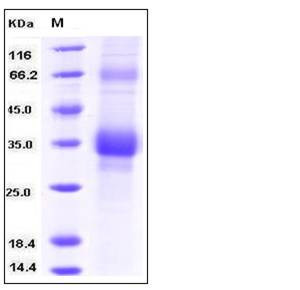Human CLEC1B / CLEC2 Protein (His Tag)
1810061I13Rik,CLEC2,CLEC2B,PRO1384,QDED721
- 100ug (NPP2023) Please inquiry
| Catalog Number | P10976-H07H |
|---|---|
| Organism Species | Human |
| Host | Human Cells |
| Synonyms | 1810061I13Rik,CLEC2,CLEC2B,PRO1384,QDED721 |
| Molecular Weight | The recombinant human CLEC1B comprises 188 amino acids with a predicted molecular mass of 22.7 kDa. As a result of glycosylation, the apparent molecular mass of rh CLEC1B is approximately 35-38 kDa in SDS-PAGE under reducing conditions. |
| predicted N | His |
| SDS-PAGE |  |
| Purity | > 76 % as determined by SDS-PAGE |
| Protein Construction | A DNA sequence encoding the human CLEC1B (NP_057593.3) extracellular domain (Gln 58-Pro 229) with a N-terminal polyhistidine tag was expressed. |
| Bio-activity | 1. Measured by its binding ability in a functional ELISA. 2. Immobilized human Podoplanin (P 10012-H08H) at 10 μg/mL (100 μl/well) can bind biotinylated human CLEC1B-His, The EC50 of biotinylated human CLEC1B-His is 0.71 μg/mL. |
| Research Area | Immunology |Inflammation / Inflammatory Mediator |Pattern Recognition Receptors |C-type Lectin Receptors |
| Formulation | Lyophilized from sterile PBS, pH 7.4 1. Normally 5 % - 8 % trehalose and mannitol are added as protectants before lyophilization. Specific concentrations are included in the hardcopy of COA. |
| Background | CLEC1B, also known as CLEC2, is a C-type lectin-like receptor expressed in myeloid cells and NK cells. Natural killer (NK) cells express multiple calcium-dependent (C-type) lectin-like receptors, such as CD94 and NKG2D, that interact with major histocompatibility complex class I molecules and either inhibit or activate cytotoxicity and cytokine secretion. CLEC2 acts as a receptor for the platelet-aggregating snake venom protein rhodocytin. Rhodocytin binding leads to tyrosine phosphorylation and this promotes the binding of spleen tyrosine kinase (Syk) and initiation of downstream tyrosine phosphorylation events and activation of PLC-gamma-2. CLEC2 contains 1 C-type lectin domain and is expressed preferentially in the liver. It acts as an attachment factor for human immunodeficiency virus type 1 (HIV-1) and facilitates its capture by platelets. |
| Reference |
